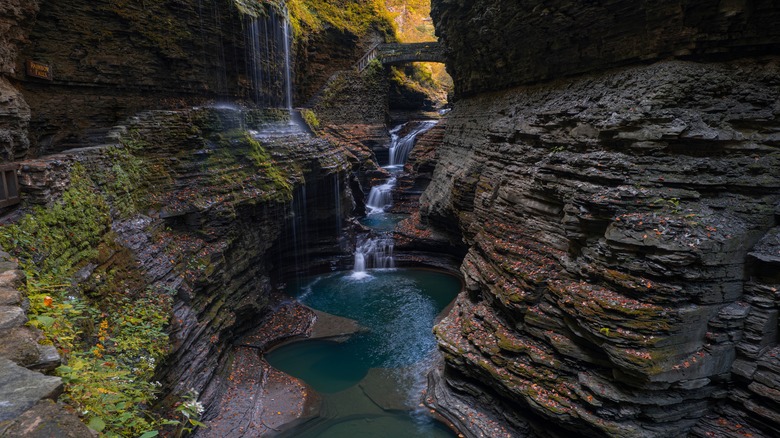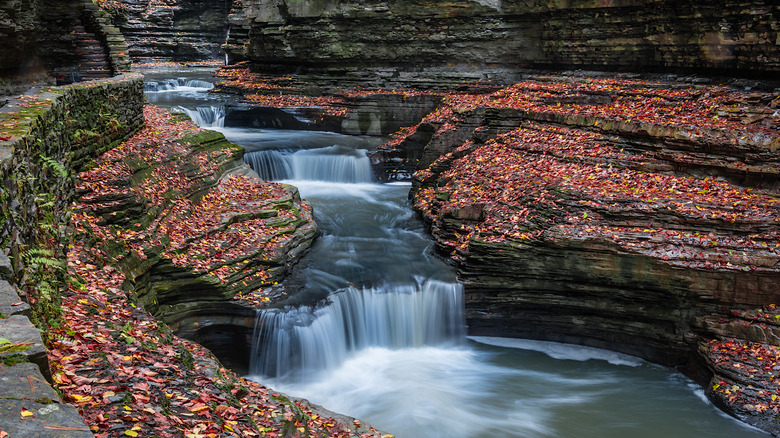In 2022 alone, nearly 1 million outdoorsy adventurers traveled from all over to visit Watkins Glen State Park and traverse through upstate New York’s idyllic woodlands. The Watkins Glen Gorge Trail is the most iconic hike of the state park, featuring panoramic, up-close views of 19 awe-inspiring cascades. Despite its popularity, this Eastern U.S. trail closes every year due to some serious hiking safety concerns.
Located in the beautiful Finger Lakes region, the Watkins Glen Gorge Trail weaves through lush forests, rocky cliffs, and pouring waterfalls. The moderate route is around 1.5 miles long but gains nearly 400 feet in elevation. As you traverse the trail, you’ll encounter unique features like Couch’s Staircase, a set of 120 fern-adorned stairs that run parallel to the gorge. You’ll also pass through Cavern Cascade, a narrow point of the path that will lead you underneath one of the waterfalls.
As you continue up the Gorge Trail, you’ll be able to stop at multiple observation points for different waterfalls, including the 60-foot-high Central Cascade and Rainbow Falls. Towards the end of the scenic route, you’ll climb Jacob’s Ladder, a set of 180 stairs that leads to the upper entrance of the state park. The trail is a must-see, but you should be aware of the potential hazards before booking your trip to Watkins Glen.
Why the Watkins Glen Gorge Trail closes

If you want to hike the Watkins Glen Gorge Trail, you’ll have to book your trip to Watkins Glen during the summer months. From early November to mid-May, the Watkins Glen Gorge Trail is closed due to dangerous conditions caused by ice, snow, and the risk of falling rock. Before the trail can be reopened in late spring, specialist New York State Park employees rappel down the trail’s cliffs to knock down any loose rocks, tree branches, and debris that could injure hikers.
The water-sculpted rocks that border the route can be quite slippery and are impacted by the natural erosion process. While the emerald punchbowls that sit below the cascades may look inviting, gorges are quite dangerous; these water features often have strong undercurrents and underwater rock ledges. At Watkins Glen, there have been tragic accounts of fatal drownings of hikers who strayed from the path, fell, or waded into prohibited swimming areas.
How to safely hike the trail

While it’s important to be aware of the potential hazards, you can safely explore and enjoy this breathtaking path by following the state park’s simple guidelines: Most importantly, stay on the designated trail to avoid falling or slipping on the rocky surfaces — yes, even experienced hikers should follow this rule. Notably, pets are never allowed on the trail because of this year-round risk of falling. Moreover, there is also absolutely no swimming allowed in the gorge. In the best case scenario, hikers can receive a $250 dollar fine per person for violating this park rule; in the worst case, it can result in a serious injury. If you are desperate to cool down on a summer day, Watkins Glen State Park does have a swimming pool by the park’s campgrounds.
Though the Watkins Glen Gorge Trail is a well-marked and popular route, bringing along a copy of the Watkins Glen State Park Trail Map to ensure you don’t wander in the wrong direction is a good idea. Hiking the Gorge Trail may seem a little daunting on the surface, but it is an overall safe hike that offers incredible vistas of Eastern US cascades.

